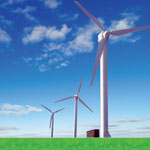 In the world of sustainable business, the words “greenhouse gases” elicit shivers down the spine, but what are greenhouse gases, really? If you ask the average person, they’d say probably something like, “Uh, bad things in the atmosphere? Something about carbon dioxide?”
In the world of sustainable business, the words “greenhouse gases” elicit shivers down the spine, but what are greenhouse gases, really? If you ask the average person, they’d say probably something like, “Uh, bad things in the atmosphere? Something about carbon dioxide?”
If we’re going to try to reduce our carbon footprints (another way of saying reducing our greenhouse gas emissions), we may as well know what greenhouse gases actually are.
By definition, greenhouse gases is not homogenous. They are a mix of lots of different gases, not all of them bad. In fact, the most prevalent greenhouse gas is actually the water vapor. Google it and you’ll find that the numbers consistently hover somewhere around 60%. Wikipedia cites this percentage as ranging between 36-72%.
In fact — and I just learned this today — without the natural greenhouse effect, the average global temperature in the lower atmosphere would be 18 degrees Celsius below zero (less than 0 degrees Farenheit). At this temperature, human life would be virtually impossible. So greenhouse gases have some beneficial effect. Who knew?
By absorbing part of the infrared radiation emitted by the ground, natural greenhouse gases raise the average temperature at the earth’s surface to a comfortable 15 degrees. (Heidelberg 2009 / 2010 Sustainability Report)
Of course, greenhouses gases have other components, as well — dangerous ones — and human activity impacts these heavily. These are the components we’re trying to reduce.
For example, the gases covered by the Kyoto Protocol include:
- carbon dioxide
- methane
- nitrous oxide
- hydrofluorocarbons
- sulfur hexafluoride
I do a lot of writing for the printing industry (which may surprise some people as being heavily focused on sustainability), and this post is inspired by today’s release of Heidelberg’s 2009 / 2010 Sustainability Report. The report opens its discussion of carbon footprint reduction with some very interesting figures:
Although CO2 is the best-known greenhouse gas, it is not the worst offender.
Methane, for example, has a global warming potential 25 times as great over a period of a hundred years, nitrous oxide 298 times, and sulfur hexafluoride (SF6) – the most powerful climate killer – 22,800 times that of carbon dioxide.
However, CO2 plays a major role because such enormous quantities of it are emitted, accounting for roughly 60% of the human-caused greenhouse gases. Every man, woman, and child on earth is responsible emitting for 4.7 tons per year.
In view of these huge amounts, reducing CO2 emissions has by far the highest priority. Today, the net CO2 emissions of a person, a product, a company, or an entire national economy serve as a measure of sustainable, long-term pro-environmental action.
The total greenhouse gases emitted by a given process – not only CO2 – are expressed as its carbon footprint. For the sake of comparability and simplicity, the other gases are converted into CO2 equivalents.
Therein ends the greenhouse gas overview. Interesting stuff, if I do say so myself. It’s just a good reminder that when we’re talking about sustainability, greenhouse gases, carbon footprints, and so on, it’s helpful to know exactly what it is we’re talking about.
Download Heidelberg’s 2009 / 2010 Sustainability Report here.










meow.